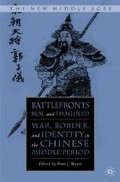Abstract
Customary scholarship on Chinese relations with foreigners during the “middle period”—the great swath of time spanning roughly from the sixth to the fourteenth century of the Common Era—has rightly emphasized the role of diplomacy. Whenever possible, diplomacy, then the default mode for conflict resolution for Chinese, was advanced as the most desirable means of settling disputes because, even in the event of failure, it was minimally destructive. The majority ethnic Han Chinese, ever the realists, viewed it as the most efficient, sustainable, and tolerable arrangement to assure coexistence with the succession of non-Han peoples arrayed along their borders. The year 2005 in fact marked the millennial anniversary of the zenith of Chinese middle-period diplomacy—the Treaty of Chanyuan. At the very beginning of 1005, the Chinese of the Song dynasty (960–1279) struck a momentous accord with the Qidan tribes of the Liao dynasty (907–1125). That particular truce remains the most celebrated event in middle-period diplomacy, resulting in more than a century of guardedly peaceful Song-Liao relations.1 Three of the six authors in this volume who treat the Song period attest to the singularity of Chanyuan as a diplomatic milestone and deliberate on its significance.
Access this chapter
Tax calculation will be finalised at checkout
Purchases are for personal use only
Preview
Unable to display preview. Download preview PDF.
Bibliography
Gelven, Michael. War and Existence: A Philosophical Inquiry. University Park: Pennsylvania State University Press, 1994.
Graff, David A. Medieval Chinese Wafare, 300–900. London: Routledge, 2002.
Lewis, Mark Edward. The Construction of Space in Early China. Albany, NY: SUNY Press, 2006.
Lorge, Peter. War, Politics and Society in Early Modern China, 900–1795. London: Routledge, 2005.
Tao Jing-shen. Two Sons of Heaven: Studies in Sung-Liao Relations. Tucson: University of Arizona Press, 1988.
Wright, David Curtis. From War to Diplomatic Parity in Eleventh-Century China: Sung’s Foreign Relations with Kitan Liao. History of Warfare, vol. 33. 47 vols. Leiden, Holland: E. J. Brill, 2005.
Editor information
Copyright information
© 2008 Don J. Wyatt
About this chapter
Cite this chapter
Wyatt, D.J. (2008). Introduction. In: Wyatt, D.J. (eds) Battlefronts Real and Imagined. The New Middle Ages. Palgrave Macmillan, New York. https://doi.org/10.1057/9780230611719_1
Download citation
DOI: https://doi.org/10.1057/9780230611719_1
Publisher Name: Palgrave Macmillan, New York
Print ISBN: 978-1-349-52631-4
Online ISBN: 978-0-230-61171-9
eBook Packages: Palgrave History CollectionHistory (R0)

